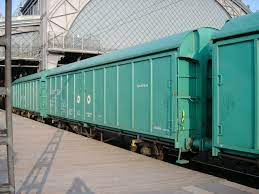Social Service Obligations /Social costs in
Indian Railways
ü
What is social service Obligation or Social cost ?
Ans: To carry out
certain transport activities which are
essentially uneconomic in nature, but in the larger interest of the
economically disadvantaged sections of the society. Losses incurred on this
account fall under Social Service Obligations of IR.
ü Losses incurred on this account fall
under Social Service Obligation of IR.
ü Social Service Obligations by IR - 2016-17
- Approx 29,600 Crores.
The
main elements of Social Service Obligation in IR are losses relating to:
(i)
Essential Commodities carried below cost;
(ii)
Passenger and Other Coaching services;
(iii)
Operation of Uneconomic Branch Lines;
(iv)
New Lines opened for Traffic during the last 15 years.
1.
Losses on transportation of
Essential Commodities carried below cost:
ü As part of the Railways’ Social
Service Obligation, certain essential commodities of mass consumption like
fruits and vegetables, sugarcane, paper, charcoal, bamboos, cotton raw pressed
etc. are carried below cost of operation in order to contain their market
prices.
ü Approximately 42 crore in 2016-17.
2.
Losses on Passenger and
Other Coaching services:
ü Analysis of
the profitability of Coaching Services in 2016-17 has revealed an overall loss
of ` 39500 crore. Out
of which, Net suburban losses in Chennai, Kolkata, Mumbai & Secunderabad –
Rs.5,389 Crores
ü Low Second class ordinary fares (sub
& non sub) constitutes 79 % of total traffic but provide only 17% of total
passenger earnings.
ü Season tickets – Non suburban constitutes 23 % of Total Non suburban traffic But
provides only 1 % of Earnings
ü Season tickets – Suburban constitutes 61
% of total traffic but provide only meager 40 % of total passenger earnings.
ü Commuters availing concession Monthly
and Quarterly Season Tickets on Suburban Sections of Chennai, Kolkata, Mumbai
and Secunderabad.
ü (iv) Concessions in Fare extended to
various categories such as (i) Recipients of gallantry awards (ii) National
sports awards (iii) Participants in National and State sports tournaments (iv)
Teachers honored with National awards (v) Shram awardees (vi) War widows (vii)
Patients suffering from cancer, tuberculosis and other serious diseases (viii)
Handicapped persons (ix) Press correspondents (x) Film technicians etc. (v)
Concessions are also extended to (i) Military traffic (ii)Postal traffic (iii)
Transportation of registered newspapers & magazines etc. and (iv) Traffic
to the North East.
ü IR also steps in to provide emergency relief
by transporting materials like food, water, fodder etc. to areas affected by
natural disasters like drought, cyclone, earthquake etc.
3.
Operation of Uneconomic
branch lines
ü Despite concerted efforts to enhance
earnings on branch lines, most of these lines remain commercially unviable.
ü The Railway Reforms Committee
recommended closure of 40 such lines but due to stiff public resistance and
opposition by State Governments towards withdrawal of such services, only 15
lines have been closed permanently by the Railways.
ü As on date 99 uneconomic branch lines
existed
ü
On
an original investment of Rs.4,476Crores on Uneconomic Branch lines, the losses
during the year 2016-17 amounted to Rs. 1,855 crore.
4.
New lines opened for traffic
during the last 15 years:
ü The Railway Convention Committee (RCC)
in its 9th Report on this subject has noted that in the present state of
Railway finances and prevalent high costs of construction, the Railways are not
in a position to inject adequate capital investment in under-developed areas.
ü Therefore, they have felt that reliefs
like making available land free of cost and waiver of dividend payment on such
lines for a minimum period of twenty years are justified.
ü Periodic reviews have revealed that of the 17
lines examined in 2016-17, as part of Social Service Obligations of the
Railways for development of backward areas, all lines are showing either
negative or unremunerative returns
Compensation for Social Service Obligations in Other Countries:
Railways,
the world over, are called upon to meet certain public service obligations at
lower tariffs for which they are adequately compensated for by the government.
Such support is provided in various forms and for different purposes like:
(i)
Compensation for losses on account of concessional tariffs;
(ii)
Out-right grant to cover deficits;
(iii)
Soft loans to meet the deficits;
(iv)
Financial support to maintain viability of the system and to earn marginal
profits;
(v)
Writing off of accumulated debts and unproductive capital; and
(vi)
Support for investment and infrastructure maintenance.
Corporate Social Responsibility
Corporate social responsibility is
the responsibility of the corporate entity towards the society in consideration
of the support given and sacrifices made by the society. The corporations
exploit the natural resources of the country, cause incidental damage to
environment and inconvenience to the people of the project area. Therefore,
they have a responsibility towards the society to share a part of their profit.
CSR and India
·
Section 135 & Schedule VII of Companies
Act, 2013
·
2 % of the average net profits of the last 3
years.
·
Activities
of reduction of poverty, education, health, environmental sustainability,
gender equality, vocation skills etc
·
Railways
wish to use CSR funds of Railway PSUs such as CONCOR, IRCTC, IRCON, RITES &
RVNL
·
For
utilising the CSR amounts to upgrade passenger amenities in major stations such
as Mumbai, Howrah, New Delhi, Guwahati, Patna, Varanasi, Vadodara, Chennai,
Agra and Bengaluru.
***
